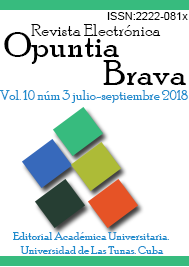The universal communist manifesto: its utility to teach and learn universal History
Keywords:
Universal history, bourgeoisie, fight of classesAbstract
The present article deals with the famous Manifesto of the Communist Party, written by Carlos Marx and Federico Engels. Emphasis is placed on the materialist conception of history, elaborated by both authors and some experiences are exposed on the use of this political and programmatic text, as an inescapable source of historical knowledge, for professors and students of the career Marxism Leninism and History, particularly, in the Universal History discipline, which is exemplified by the teaching-learning process of Universal History I, which includes the Ancient and Medieval periods.
Downloads
Download data is not yet available.
Downloads
Published
2018-09-25
How to Cite
Quintero Díaz, C., Garcés Fernández, E., & Fonticiella Izquierdo, E. L. (2018). The universal communist manifesto: its utility to teach and learn universal History. Opuntia Brava, 10(3), 37–44. Retrieved from https://opuntiabrava.ult.edu.cu/index.php/opuntiabrava/article/view/537
Issue
Section
Articles






















